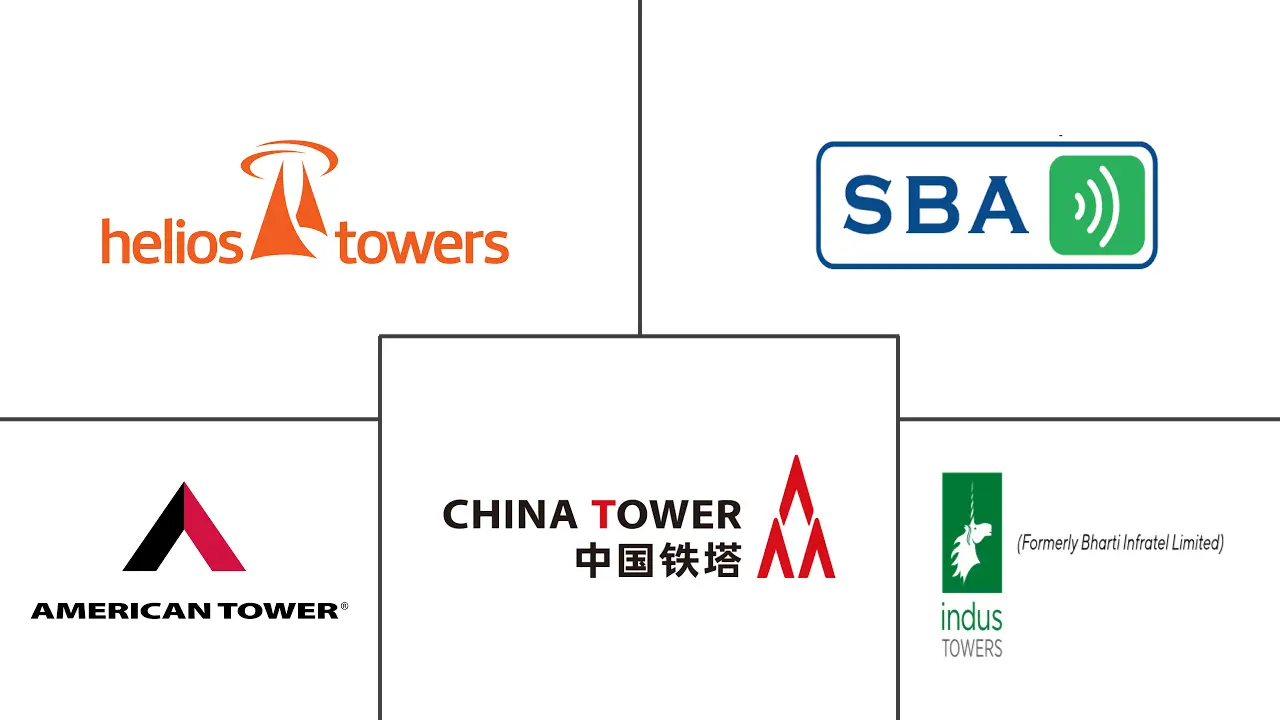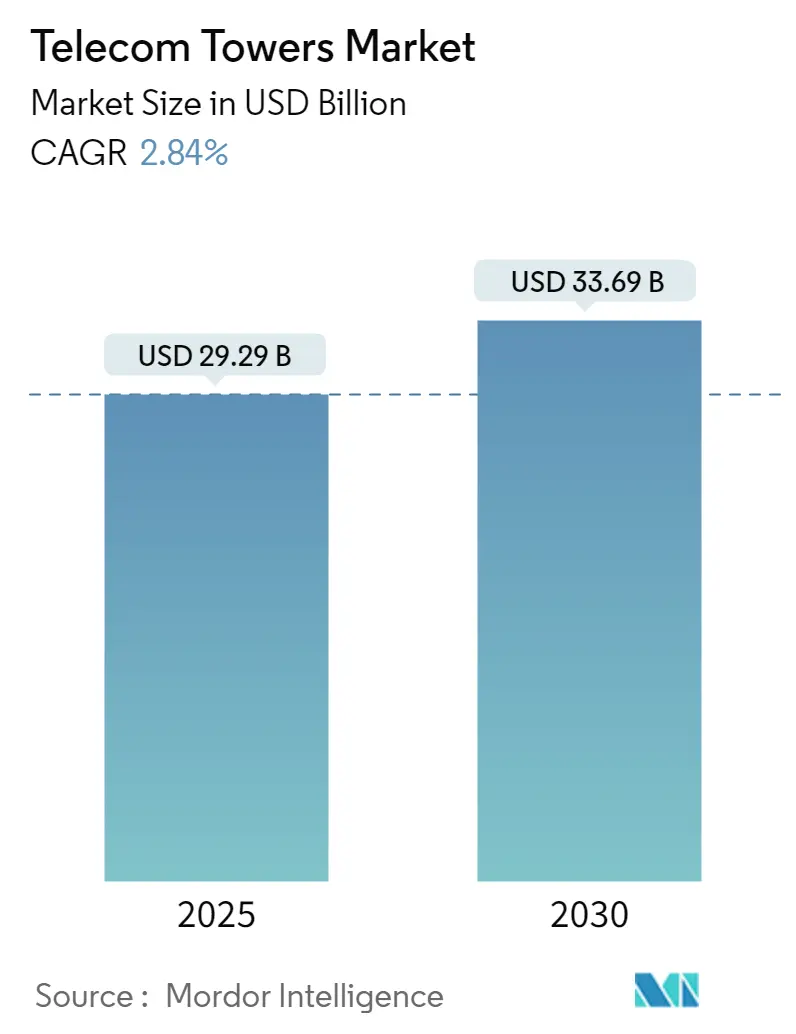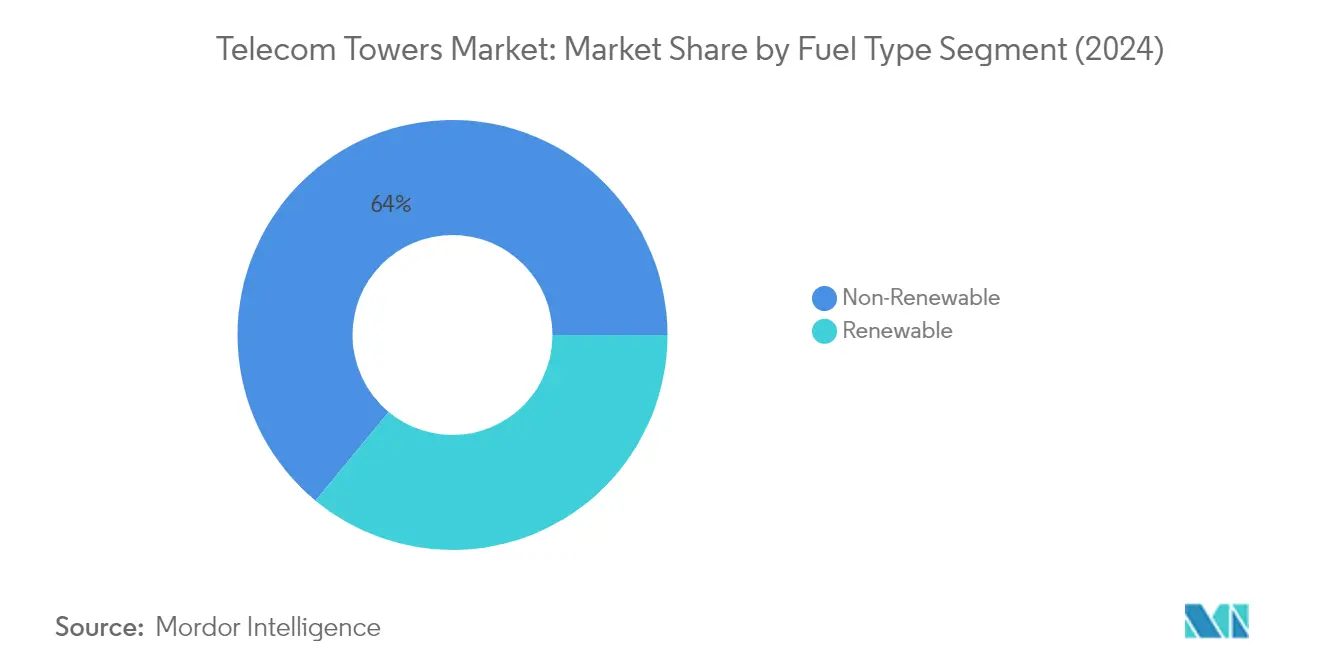Telecom Towers Market Analysis
The Telecom Towers Market size is estimated at USD 29.29 billion in 2025, and is expected to reach USD 33.69 billion by 2030, at a CAGR of 2.84% during the forecast period (2025-2030).
The telecom tower industry is experiencing significant transformation driven by tower sharing and technological convergence. Tower companies are increasingly adopting shared telecom infrastructure models, with independent tower companies managing and operating towers for multiple mobile network operators. This shift is particularly evident in Europe, where the share of independent TowerCos has increased from 17% in 2018 to 20% in 2020, though still lagging behind markets like the United States (90%) and India (52%). According to Cisco's projections, the number of devices connected to IP networks is expected to reach 29.3 billion by 2023, with Machine-to-Machine (M2M) connections projected to grow from 33% to 50% of total connections, driving the need for robust tower infrastructure.
Environmental sustainability has emerged as a critical focus area for tower companies worldwide, with many operators transitioning towards renewable energy sources. Tower companies are implementing innovative power solutions, including solar and hybrid technologies, to reduce dependence on diesel generators and minimize environmental impact. According to GSMA research, while 88% of off-grid and bad-grid towers in low and middle-income countries still rely on non-renewable sources, there is a significant push towards green energy adoption, driven by both environmental concerns and operational cost considerations. Tower companies are increasingly partnering with Energy Service Companies (ESCOs) to manage power infrastructure more efficiently and sustainably.
The integration of telecom towers into smart city infrastructure represents a major industry evolution, with tower companies expanding beyond traditional services. Tower companies are now offering comprehensive solutions including passive infrastructure, small cells, Wi-Fi, and fiber connectivity for smart city deployments. The industry is witnessing the installation of smart poles that serve multiple purposes, including improved cellular coverage, surveillance systems, traffic management, and smart lighting services. According to GSMA Intelligence data, the average data usage per smartphone globally is expected to reach 41 GB per month by 2027, necessitating denser network infrastructure in urban areas.
The advancement of 5G technology is reshaping tower infrastructure requirements and deployment strategies. Tower companies are adapting their infrastructure to support the unique demands of 5G networks, including network densification through small cells and edge computing capabilities. The next-generation telecom equipment tends to be larger and heavier than previous hardware, requiring tower companies to upgrade their structures and evaluate installation requirements more stringently. Tower operators are increasingly incorporating advanced technologies such as Artificial Intelligence and Machine Learning for enhanced network experience, predictive maintenance, and operational optimization, while also exploring opportunities in edge computing and private networks utilizing Citizens Broadband Radio Service technology.
Telecom Towers Market Trends
Connecting/Improving Connectivity to Rural Areas
The increasing emphasis on improving internet connectivity in rural areas is emerging as a major factor driving the deployment and enhancement of telecom infrastructure in these regions. Governments worldwide are implementing various initiatives and policies to expand network infrastructure in rural areas, recognizing the critical need to bridge the digital divide. For instance, the Nigerian Communications Commission (NCC) has developed robust regulations and guidelines for the telecommunications sector, including specific technical specifications for the installation of masts and cell towers, to ensure proper infrastructure deployment in underserved areas. Similarly, Saudi Arabia's Vision 2030 has transformed the country into a digital center through favorable laws and government funding, with initiatives like STC's Mena HUB investing USD 1 billion in regional connectivity and infrastructure.
Telecom tower companies are actively participating in rural connectivity initiatives through innovative solutions and strategic partnerships. Companies are offering cost-effective solutions specifically designed for rural deployments, including hybrid power solutions and optimized tower infrastructure designs that can be deployed in challenging terrains. For example, Egypt's Ministry of Communications and Information Technology (MCIT) has been working to build secure, reliable, and accessible infrastructure as part of its digital society transition initiative. These developments are complemented by telecom operators' efforts to expand their rural coverage, with many companies implementing shared infrastructure models to make rural deployments more economically viable while ensuring widespread connectivity access.
Improving and Catering to Increasing Data Needs
The exponential growth in data consumption and the evolution of 5G technology are creating unprecedented demands for robust wireless infrastructure. According to Ericsson's forecast, the number of 5G tower subscriptions is expected to reach almost 4.7 billion by 2028, highlighting the massive infrastructure requirements needed to support this growth. This surge in data needs is driving telecom companies to densify their networks, particularly in urban areas where capacity demands are highest. The trend is evident in recent developments, such as DISH's October 2023 initiative to install three antennas on the roof of the 16-story Residence Inn Hotel in White Plains, demonstrating the industry's focus on expanding infrastructure to meet growing data demands.
The implementation of 5G networks requires significant infrastructure investments, particularly in rooftop and facade installations that are crucial for network densification. According to American Tower Corporation (ATC), the number of wireless transmission points, including base station and small cells, is expected to increase from 780,000 to over a million to serve the growing 5G market effectively. Building facades and rooftops are becoming increasingly important as they provide ideal locations for MNOs to expand their capacity and coverage, enabling direct 5G signal delivery to customers through improved line of sight. This infrastructure expansion is particularly critical in urban settings, where reliable 5G reception is essential for both ground-level users and devices near building boundaries, supporting the increasing demand for high-speed data services and emerging technologies.
Segment Analysis: By Fuel Type
Non-Renewable Segment in Telecom Towers Market
The non-renewable fuel type segment continues to dominate the telecom towers market, holding approximately 64% market share in 2024. This significant market position is primarily driven by the widespread dependence on diesel generators for backup power, particularly in regions with unreliable grid connectivity. The segment's dominance is especially pronounced in low and middle-income countries, where about 88% of off-grid and bad-grid towers still rely on non-renewable sources. Telecom operators largely depend on these backup power systems to maintain an uninterrupted power supply, prevent outages, and ensure continuous operation of cell towers, equipment, and networks, especially during climate instabilities. However, factors such as unregulated diesel prices, carbon dioxide emissions, and diesel pilferage challenges in rural areas have begun to impact this segment's growth trajectory.
Renewable Segment in Telecom Towers Market
The renewable fuel type segment in the telecom tower market is experiencing robust growth as telecom tower companies worldwide increasingly adopt renewable energy sources amid mounting pressure from rising liquid fuel costs and operating expenses. This transition is being accelerated by government initiatives and environmental regulations promoting green technology adoption. The segment's growth is further supported by the development of strong off-grid technology, declining PV prices, and increasing availability of Energy Service Companies (ESCOs). Companies are implementing various renewable solutions, including solar panels, wind turbines, and hybrid systems, demonstrating the sector's commitment to sustainable practices. The integration of these technologies not only helps reduce operational costs but also enables profitable expansion of mobile networks to rural and low-population-density areas.
Segment Analysis: By Type of Tower
Lattice Towers Segment in Telecom Towers Market
Lattice towers continue to dominate the telecom towers market, commanding approximately 42% market share in 2024. These towers, which feature a stem pattern assembled and joined to create a self-supporting frame, range in height from 30 to 120 meters and are preferred for their sturdy construction and ability to withstand wind pressure and diverse geographic conditions. The segment's leadership position is driven by their high strength-to-weight ratio, flexibility in structural design, and superior capability to host multiple telecommunications accessories, including antenna mounts, platforms, lightning protection kits, safety equipment, and obstruction lights. These towers are particularly valued for their versatility in supporting GSM/CDMA, radar, and video surveillance equipment installations, making them the preferred choice for major telecommunications infrastructure deployments worldwide.
Monopole Towers Segment in Telecom Towers Market
The monopole towers segment is emerging as the most dynamic growth sector in the telecom towers market for the period 2024-2029. These single-pole structures, typically ranging between 100 and 170 feet in height, are gaining significant traction due to their cost-effectiveness, simpler installation process, and minimal space requirements. The growth is primarily driven by their increasing adoption in urban areas where space constraints are critical, their suitability for 5G infrastructure deployment, and their ability to support multiple antennas with incremental vertical spacing of 10 to 15 feet. Their constrained tubular construction requires fewer materials and manufactured parts, making them not only the least invasive option but also highly economical for telecommunications providers looking to expand their network coverage efficiently.
Remaining Segments in Telecom Towers Market
The telecom towers market is further segmented by guyed towers and stealth towers, each serving specific market needs. Guyed towers, supported by guy lines for additional stability, are particularly valuable in applications requiring heights between 200-300 feet and can accommodate multiple wireless tenants. Stealth towers, designed to mimic natural features or man-made structures, play a crucial role in areas with strict aesthetic requirements or zoning regulations. These specialized tower types complement the broader market by providing solutions for specific deployment scenarios, whether it's achieving greater heights with guyed towers or maintaining visual harmony with the surrounding environment through stealth designs.
Segment Analysis: By Installation
Ground-based Segment in Telecom Towers Market
The ground-based segment continues to dominate the global telecom towers market, holding approximately 68% market share in 2024. Ground-based towers, typically ranging from 30 to 200 meters in height, offer superior load-bearing capacity and can support up to twelve panel antennas and three microwave solid dish antennas with a diameter of 0.6 meters each. These towers are particularly favored for their structural stability and ability to accommodate multiple tenants, making them cost-effective solutions for telecom operators. The segment's strong position is further reinforced by increasing investments in 5G infrastructure deployment and the growing demand for improved network coverage in rural and suburban areas. Ground-based towers are also becoming increasingly important for supporting emerging technologies like edge computing and IoT applications, which require robust infrastructure for optimal performance.
Rooftop Segment in Telecom Towers Market
The rooftop tower segment is emerging as the fastest-growing category in the telecom towers market, projected to grow at approximately 4% from 2024 to 2029. This growth is primarily driven by the increasing demand for network densification in urban areas where space constraints make traditional ground-based towers impractical. Mobile Network Operators (MNOs) are increasingly recognizing rooftop tower installations as crucial components for their 5G network expansion strategies, particularly in metropolitan areas where building facades and rooftops provide ideal locations for achieving direct line-of-sight transmission. The segment's growth is further accelerated by the rising adoption of small cell tower and distributed antenna systems (DAS) in urban environments, along with the cost advantages offered by rooftop tower installations compared to traditional tower construction. Additionally, rooftop sites are gaining popularity due to their ability to provide enhanced coverage in high-density areas while minimizing visual impact on the urban landscape.
Segment Analysis: By Ownership
Operator Owned Segment in Telecom Towers Market
The operator-owned segment continues to dominate the global telecom towers market, holding approximately 43% market share in 2024. This significant market position is driven by multiple mobile network operators (MNOs) taking direct responsibility for the construction, operation, and maintenance of their tower infrastructure. The segment's dominance reflects the strategic importance many operators place on maintaining control over their critical infrastructure assets. Operators are increasingly focusing on network optimization and expansion strategies, particularly in emerging markets where direct infrastructure control is crucial for service quality. The segment benefits from operators' ability to implement advanced technologies and maintain high service standards through direct management of tower assets. Additionally, operator-owned towers often serve as strategic assets that can be monetized through sale-and-leaseback arrangements when operators need to optimize their capital structure.
MNO Captive Segment in Telecom Towers Market
The MNO captive segment is emerging as the most dynamic segment in the telecom towers market, projected to grow at approximately 5% through 2024-2029. This robust growth is primarily driven by the increasing need for dedicated network infrastructure to support 5G deployments and expanding mobile broadband coverage. MNO captive towers are becoming increasingly important as operators seek to maintain strategic control over their network assets while optimizing operational efficiency. The segment's growth is further supported by the rising demand for specialized infrastructure solutions, particularly in urban areas where network densification is crucial. Technological advancements in network equipment and the increasing focus on energy-efficient tower operations are also contributing to the segment's expansion. The trend toward network modernization and the need for customized infrastructure solutions continues to drive investment in MNO captive towers.
Remaining Segments in Telecom Towers Market by Ownership
The joint venture and private-owned segments represent important alternative ownership models in the telecom towers market. Joint ventures enable multiple operators to pool their infrastructure resources, leading to cost optimization and improved network coverage through shared investments. These arrangements are particularly prevalent in emerging markets where infrastructure sharing can significantly reduce deployment costs. The private-owned segment, operated by independent tower companies, offers flexible infrastructure solutions and specialized expertise in tower management. These segments play a crucial role in promoting infrastructure sharing, reducing duplicate investments, and supporting sustainable network expansion. Private tower companies often bring innovative business models and operational efficiencies, while joint ventures facilitate collaborative approaches to network deployment and management.
Telecom Towers Market Geography Segment Analysis
Telecom Towers Market in North America
The North American telecom towers market demonstrates robust infrastructure development across the United States and Canada. The region's advanced telecommunications sector is characterized by extensive 5G deployment, increasing network densification efforts, and growing demand for improved connectivity in both urban and rural areas. Both countries are witnessing significant investments in tower infrastructure modernization, with major telecom operators focusing on expanding their coverage while optimizing existing tower assets through colocation and infrastructure-sharing arrangements.
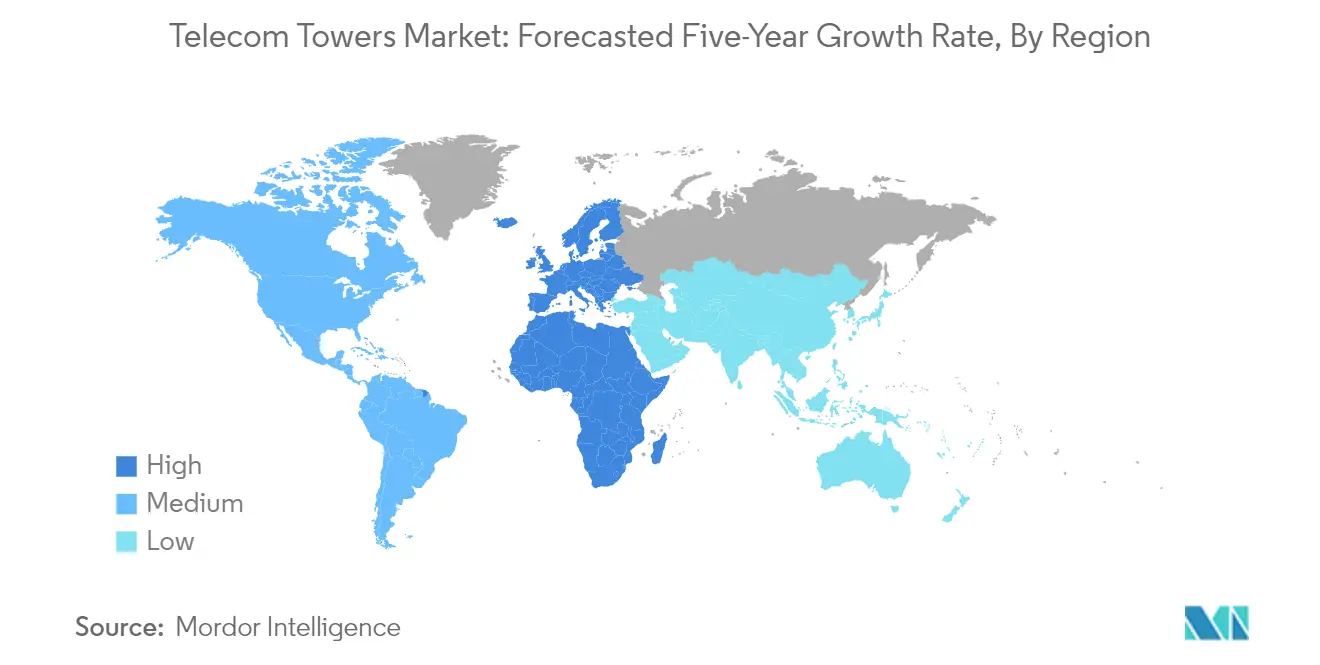
Telecom Towers Market in United States
The United States leads the North American market with approximately 78% market share in 2024, driven by extensive 5G rollout initiatives and increasing demand for high-speed mobile connectivity. The country's telecom infrastructure benefits from supportive government policies promoting rural connectivity and digital transformation. Major tower companies are actively expanding their portfolios through strategic acquisitions and new tower construction, particularly focusing on urban densification and suburban expansion projects. The market is characterized by strong competition among independent tower companies and mobile network operators, with increasing emphasis on edge computing capabilities and smart city initiatives.
Telecom Towers Market in Canada
Canada emerges as the fastest-growing market in North America with an expected growth rate of approximately 3% during 2024-2029. The country's telecom tower sector is experiencing significant transformation driven by government initiatives to improve rural connectivity and bridge the digital divide. Canadian operators are increasingly focusing on tower sharing and colocation strategies to optimize infrastructure investments while expanding coverage to remote areas. The market is witnessing increased deployment of multi-tenant wireless towers and innovative infrastructure solutions to support next-generation wireless technologies and improved network coverage across its vast geography.
Telecom Towers Market in Europe
The European telecom towers market showcases a diverse landscape across multiple countries, with varying levels of infrastructure development and market maturity. The region is characterized by increasing tower-sharing agreements and the emergence of independent tower companies through carrier tower spin-offs. Countries across Europe are actively working on network modernization initiatives, with particular focus on supporting 5G deployment and improving rural connectivity.
Telecom Towers Market in Germany
Germany maintains its position as the largest telecom tower market in Europe, commanding approximately 15% market share in 2024. The country's market is characterized by strong infrastructure investment, particularly in 5G network deployment and digital transformation initiatives. The German market benefits from advanced technological adoption, a strong regulatory framework, and increasing demand for high-speed mobile connectivity across both urban and rural areas. Major telecom operators and towercos are actively expanding their infrastructure while focusing on energy efficiency and environmental sustainability.
Telecom Towers Market in Spain
Spain emerges as Europe's fastest-growing telecom tower market with an expected growth rate of approximately 4% during 2024-2029. The country's market is experiencing significant transformation through increased tower-sharing agreements and infrastructure modernization initiatives. Spanish operators are actively investing in network densification and coverage expansion, particularly in urban areas and tourist destinations. The market is witnessing increased participation from independent towercos and innovative infrastructure solutions to support growing mobile data traffic and 5G deployment.
Telecom Towers Market in Asia-Pacific
The Asia-Pacific telecom towers market represents a dynamic landscape with diverse market conditions across developed and emerging economies. The region encompasses mature markets like Japan and South Korea, alongside rapidly developing markets such as India and Indonesia. Tower sharing and infrastructure optimization initiatives are gaining prominence across the region, with increasing focus on expanding rural connectivity and supporting growing mobile data consumption.
Telecom Towers Market in China
China maintains its position as the dominant force in the Asia-Pacific telecom tower market. The country's tower infrastructure benefits from strong government support, extensive 5G deployment initiatives, and increasing demand for mobile connectivity. Chinese tower companies are focusing on infrastructure optimization and energy efficiency while expanding coverage in both urban and rural areas. The market demonstrates strong collaboration between tower companies and mobile operators in network deployment and infrastructure sharing.
Telecom Towers Market in India
India emerges as the fastest-growing market in the Asia-Pacific region. The country's telecom tower sector is undergoing rapid transformation driven by aggressive 5G rollout plans, increasing mobile data consumption, and government initiatives supporting digital connectivity. Indian tower companies are actively expanding their portfolios while focusing on green energy solutions and infrastructure sharing to optimize costs and improve operational efficiency. The market is witnessing increased investment in both urban and rural areas to support growing mobile connectivity demands.
Telecom Towers Market in Latin America
The Latin American telecom towers market demonstrates varying levels of development across countries, with Brazil and Mexico leading the regional infrastructure deployment. The region is characterized by increasing tower-sharing agreements and the emergence of independent tower companies. Brazil emerges as the largest market while Colombia shows the fastest growth rate in the region. Countries across Latin America are focusing on expanding mobile coverage in rural areas and upgrading existing infrastructure to support growing data consumption and future 5G deployments.
Telecom Towers Market in Middle East and Africa
The Middle East and Africa telecom towers market presents a diverse landscape with varying levels of infrastructure development across countries. The region encompasses both advanced markets in the Gulf Cooperation Council (GCC) countries and emerging markets in Africa. Saudi Arabia emerges as the largest market while Tanzania demonstrates the fastest growth rate in the region. The market is characterized by increasing tower-sharing initiatives, growing investment in rural connectivity, and efforts to optimize network infrastructure deployment costs while expanding mobile coverage across diverse geographical terrains.
Telecom Towers Industry Overview
Top Companies in Telecom Towers Market
The telecom towers market features prominent players like American Tower Corporation, Helios Towers, Indus Towers, China Tower Corporation, SBA Communications, AT&T, and Crown Castle International leading the industry. These companies are increasingly focusing on technological innovation through the integration of AI and automation for predictive maintenance and network optimization. Operational agility is being enhanced through the adoption of hybrid power solutions and energy-efficient systems, particularly in developing regions. Strategic partnerships and joint ventures have become crucial for market expansion, with companies actively pursuing tower-sharing agreements and co-location opportunities. Geographic expansion strategies are predominantly centered around emerging markets in Asia-Pacific and Africa, where digital infrastructure development is rapidly accelerating. Companies are also investing heavily in infrastructure upgrades to support 5G deployment and edge computing capabilities, while simultaneously exploring opportunities in small cell densification and fiber connectivity.
Market Consolidation Drives Industry Evolution Pattern
The telecom towers market exhibits a mix of global infrastructure giants and regional specialists, with international players dominating developed markets while local operators maintain strong positions in emerging economies. Market consolidation has been a defining characteristic, driven by the need for operational efficiency and an expanded geographic footprint. Major players are increasingly pursuing strategic acquisitions and mergers to strengthen their market presence, particularly evident in regions like Europe and Southeast Asia where regulatory environments are conducive to consolidation. The industry has witnessed significant transformation through tower spin-offs from traditional telecom operators, creating independent tower company entities that focus exclusively on tower infrastructure management and optimization.
The market structure is characterized by high barriers to entry due to substantial capital requirements and regulatory complexities, leading to a relatively concentrated competitive landscape. Joint ventures and strategic partnerships have emerged as preferred growth strategies, particularly in markets with strict foreign ownership restrictions. The industry has seen a notable trend of traditional mobile network operators divesting their tower assets to specialized tower company entities, enabling them to focus on core service delivery while optimizing capital allocation. This shift has created opportunities for infrastructure investment firms and specialized tower companies to expand their portfolios through sale-and-leaseback arrangements.
Innovation and Adaptability Drive Future Success
For incumbent players to maintain and expand their market share, focus on technological innovation and operational efficiency has become paramount. Companies are investing in smart tower solutions incorporating IoT sensors and advanced monitoring systems to optimize maintenance and reduce operational costs. The ability to provide integrated solutions beyond traditional tower leasing, including edge computing capabilities and specialized urban solutions like small cells, has become increasingly important. Successful market leaders are also emphasizing sustainable practices through green energy adoption and implementing advanced power management systems to address growing environmental concerns and operational cost challenges.
New entrants and challenger companies can gain ground by focusing on underserved markets and specialized solutions for specific industry segments. Success factors include developing innovative funding models, forming strategic partnerships with established players, and leveraging new technologies to create differentiated offerings. The industry faces moderate substitution risk from emerging technologies like satellite communications, though the growing demand for dense mobile networks, particularly in urban areas, continues to support traditional cellular tower companies infrastructure. Regulatory considerations, particularly around 5G deployment and environmental impact, are becoming increasingly important in shaping competitive strategies. Companies that can effectively navigate these regulatory requirements while maintaining operational efficiency are better positioned for long-term success.
Telecom Towers Market Leaders
-
American Tower Corporation
-
Helios Towers PLC
-
Indus Towers Limited (Bharti Infratel)
-
China Tower Corporation
-
SBA Communications Corporation
- *Disclaimer: Major Players sorted in no particular order
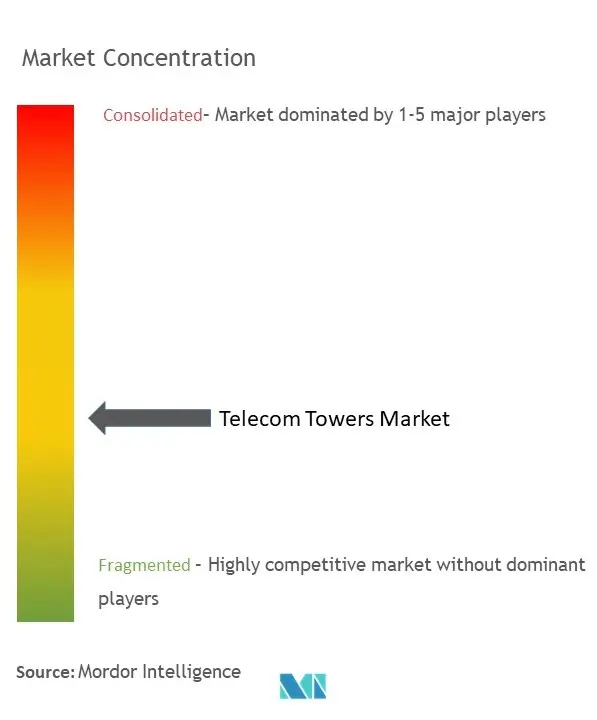
Telecom Towers Market News
- April 2024: TowerCo. of Africa Uganda secured USD 40 million in funding to expand coverage in the country's rural areas. The financing, to be disbursed over a 10-year period, comes from the European Investment Bank, the Development Bank of Austria (OeEB), and the Belgian Investment Company for Developing Countries. TowerCo. of Africa Uganda plans to install 506 new telecom towers strategically located in rural regions that currently lack mobile network access or where existing networks are saturated. These towers will provide rural communities access to 4G and 5G data services and mobile money solutions and promote financial inclusion.
- November 2023: Telxius partnered with the Firmina Subsea cable system. This system will connect the US East Coast to Las Toninas, Argentina, with additional landings in Praia Grande, Brazil, and Punta Del Este, Uruguay. Telxius will be hosting Firmina at its Santos digital hub in Brazil.
- August 2023: STC Group, a pioneer in digital transformation in the Middle East and Africa, announced that its subsidiary, TAWAL, had started its operations in Europe. The acquisition of the telecom tower assets of United Group in the Republic of Bulgaria, the Republic of Croatia, and the Republic of Slovenia, as part of STC’s strategy to grow and expand, and after all relevant regulatory approvals had been received. With the acquisition of the assets, TAWAL currently owns and operates more than 4.800 sites across three countries (Bulgarian, Croatian, and Slovenian) and provides operation services to new clients in those countries.
Telecom Towers Industry Segmentation
A telecommunication tower can be of any structure, including monopoles, tripoles, lattice towers, guyed towers, self-support towers, poles, masts, or similar structures. These towers support one or more telecommunication antennas, allowing radio communications. They can be placed on the ground or a building's rooftop, including equipment storage and storing electronic components. These towers do not require regular staffing and require periodic maintenance. The growth of telecom towers is set to continue during the forecast period, owing to the deployment of 5G infrastructure.
The telecom towers market is segmented by fuel type (renewable and non-renewable), type of tower (lattice tower, guyed tower, monopole tower, and stealth tower), installation (rooftop and ground-based), ownership (operator-owned, joint venture, private-owned, MNO captive), and geography (North America [United States and Canada], Europe (United Kingdom, Germany, France, Italy, Spain, Netherlands, Sweden, Switzerland, and Rest of Europe], Asia-Pacific [China, India, Japan, South Korea, Indonesia, Vietnam, Malaysia, Philippines, Australia and New Zealand, and Rest of Asia-Pacific], Latin America [Brazil, Mexico, Argentina, Central America, Columbia, and Rest of Latin America], and Middle East and Africa [Saudi Arabia, Egypt, Algeria, Nigeria, South Africa, Tanzania, Morocco, and Rest of Middle East and Africa]). The market sizes and forecasts are provided in terms of value (USD) for all the above segments.
| By Fuel Type | Renewable | ||
| Non-renewable | |||
| By Type of Tower | Lattice Tower | ||
| Guyed Tower | |||
| Monopole Towers | |||
| Stealth Towers | |||
| By Installation | Rooftop | ||
| Ground-based | |||
| By Ownership | Operator-owned | ||
| Joint Venture | |||
| Private-owned | |||
| MNO Captive | |||
| By Geography | North America | United States | |
| Canada | |||
| Europe | United Kingdom | ||
| Germany | |||
| France | |||
| Italy | |||
| Spain | |||
| Netherlands | |||
| Sweden | |||
| Switzerland | |||
| Rest of Europe | |||
| Asia-Pacific | China | ||
| India | |||
| Japan | |||
| South Korea | |||
| Indonesia | |||
| Vietnam | |||
| Malaysia | |||
| Philippines | |||
| Australia and New Zealand | |||
| Rest of Asia-Pacific | |||
| Latin America | Brazil | ||
| Mexico | |||
| Argentina | |||
| Rest of Latin America | |||
| Middle East and Africa | Saudi Arabia | ||
| Egypt | |||
| Algeria | |||
| Nigeria | |||
| South Africa | |||
| Tanzania | |||
| Morocco | |||
| Rest of Middle East and Africa | |||
Telecom Towers Market Research FAQs
How big is the Telecom Towers Market?
The Telecom Towers Market size is expected to reach USD 29.29 billion in 2025 and grow at a CAGR of 2.84% to reach USD 33.69 billion by 2030.
What is the current Telecom Towers Market size?
In 2025, the Telecom Towers Market size is expected to reach USD 29.29 billion.
Who are the key players in Telecom Towers Market?
American Tower Corporation, Helios Towers PLC, Indus Towers Limited (Bharti Infratel), China Tower Corporation and SBA Communications Corporation are the major companies operating in the Telecom Towers Market.
Which is the fastest growing region in Telecom Towers Market?
Asia Pacific is estimated to grow at the highest CAGR over the forecast period (2025-2030).
Which region has the biggest share in Telecom Towers Market?
In 2025, the Middle East and Africa accounts for the largest market share in Telecom Towers Market.
What years does this Telecom Towers Market cover, and what was the market size in 2024?
In 2024, the Telecom Towers Market size was estimated at USD 28.46 billion. The report covers the Telecom Towers Market historical market size for years: 2019, 2020, 2021, 2022, 2023 and 2024. The report also forecasts the Telecom Towers Market size for years: 2025, 2026, 2027, 2028, 2029 and 2030.
Our Best Selling Reports
Telecom Towers Market Research
Mordor Intelligence provides a comprehensive analysis of the telecom towers market. We leverage our extensive expertise in wireless infrastructure and communication infrastructure research. Our detailed examination covers the complete ecosystem of cellular towers, mobile towers, and telecommunication towers. This includes various structure types such as lattice tower, monopole tower, guyed tower, and rooftop tower installations. The analysis encompasses crucial developments in network infrastructure. It ranges from traditional base station deployments to emerging 5G tower and 4G tower technologies. All this information is available in an easy-to-download report PDF format.
Our research provides stakeholders with actionable insights into tower sharing practices, towerco operations, and telecom site management strategies. The report examines the evolution of wireless communication tower technologies, including small cell tower implementations and macro cell tower developments. We analyze how tower infrastructure companies are adapting to meet the increasing demand for wireless infrastructure solutions. Our detailed coverage of telecom infrastructure trends helps industry leaders make informed decisions. The comprehensive analysis includes insights into tower company operations and wireless tower deployment strategies across global markets.

